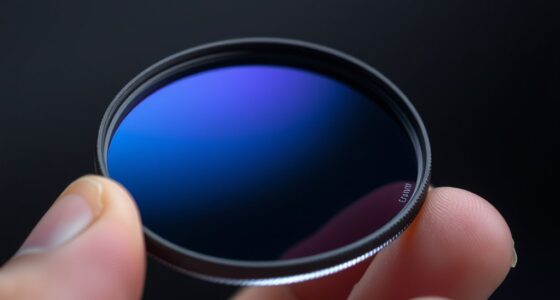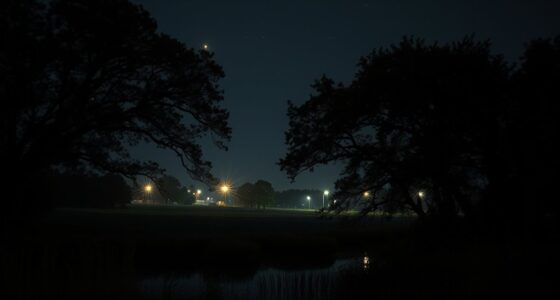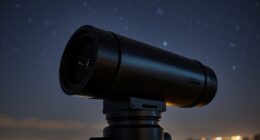Many believe that narrowband filters are always better for deep-sky imaging, but broadband filters can be sufficient for brighter objects and daytime scenes. It’s a misconception that broadband filters only work during the day, or that they can capture faint or distant objects effectively. Also, the high cost of narrowband filters is justified by their performance, but not all filters with similar wavelengths perform equally. Continue exploring to discover the full truths about these essential tools.
Key Takeaways
- Narrowband filters are primarily for deep-sky imaging and light pollution reduction, not daytime daylight photography.
- Broadband filters do not effectively isolate specific wavelengths, limiting their usefulness for detailed spectral analysis.
- Investing in narrowband filters is justified by their superior contrast, especially in light-polluted environments, despite higher costs.
- Not all filters targeting similar wavelengths perform equally; spectral precision and coating quality greatly influence effectiveness.
- Narrowband and broadband filters serve different purposes; using them interchangeably often leads to suboptimal imaging results.
Narrowband Filters Are Always Better for Deep-Sky Imaging
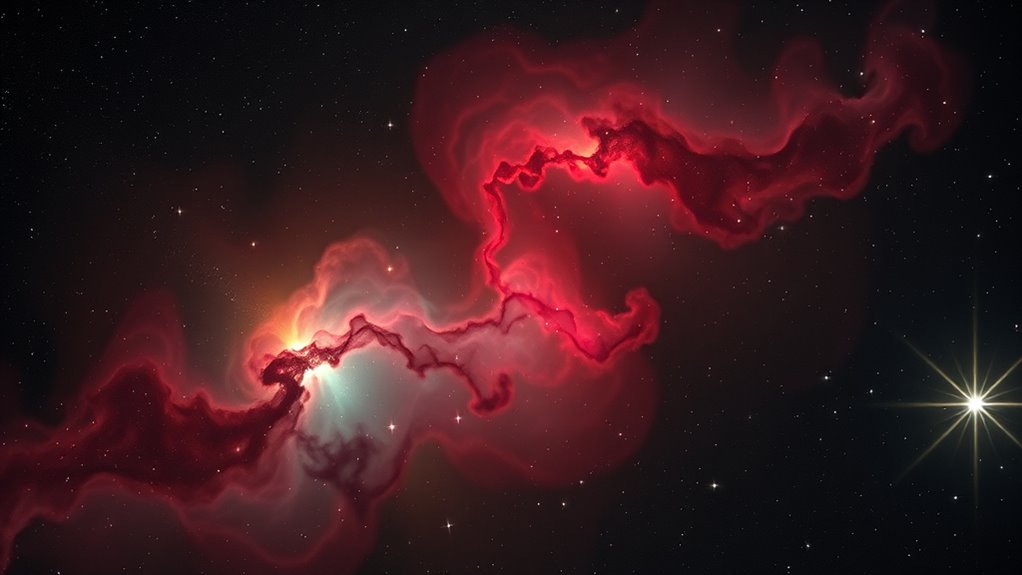
Narrowband filters are generally considered superior for deep-sky imaging because they can isolate specific wavelengths of light emitted by celestial objects, such as emission nebulae. This is due to their high spectral precision, which allows you to target narrow bands of wavelengths with remarkable accuracy. Wavelength specificity ensures you capture only the light emitted by particular elements like hydrogen or oxygen, reducing interference from light pollution and skyglow. As a result, your images become sharper, with higher contrast and detail. This focused approach enables you to see faint structures that broad filters might miss. By honing in on precise spectral lines, narrowband filters give you a clearer, more detailed view of deep-sky objects, making them the preferred choice for astrophotographers aiming for depth and clarity. Spectral lines are the specific wavelengths of light emitted by elements, crucial for achieving the high contrast in deep-sky imaging.
Broadband Filters Are Only Useful for Daytime Photography
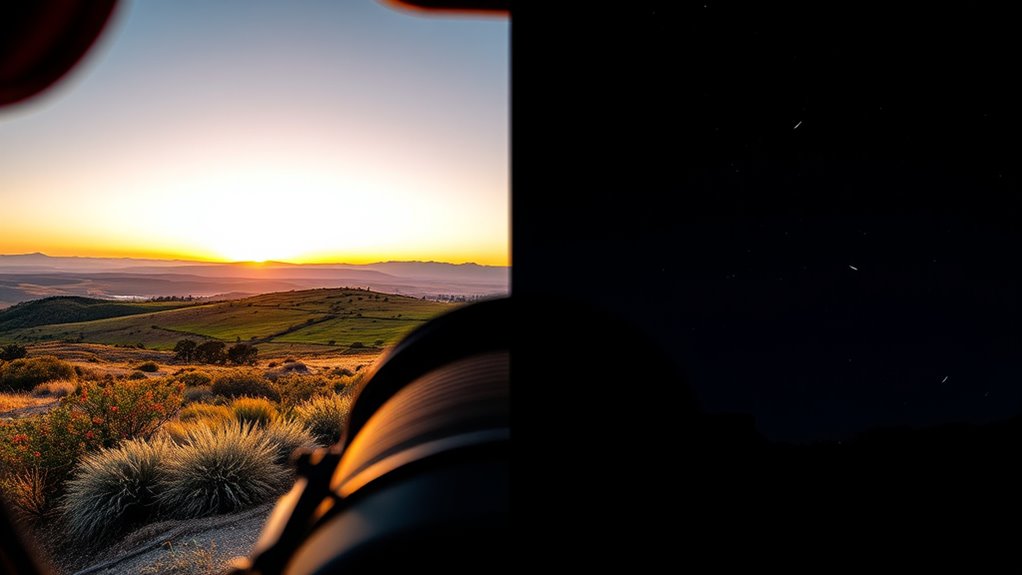
Many believe broadband filters are best suited for daytime photography, but they also offer advantages for nighttime imaging. Their spectrum flexibility allows you to capture a wider range of celestial objects, opening up creative options. This versatility can enhance your artistic expression, even under dark skies. Additionally, understanding juice cleansing can help you optimize your health and recovery after long nights of astrophotography.
Nighttime Imaging Benefits
While broadband filters are primarily designed for daytime photography, they offer limited benefits for nighttime imaging. They can help with light pollution reduction, but their advantages are often minimal in dark skies. Consider these points:
- They can slightly improve contrast in urban areas by reducing some specific light pollution sources.
- They’re useful for general nighttime imaging, especially when capturing scenes with mixed lighting conditions.
- They allow more natural color rendition compared to narrowband filters, preserving the scene’s true hues.
- They’re versatile for various subjects, from cityscapes to landscape astrophotography, without needing specialized filters.
However, for deep-sky objects, narrowband filters typically outperform broadband options in nighttime imaging. Broadband filters mainly excel in daytime applications but have some utility in urban nighttime environments.
Spectrum Flexibility Limitations
Broadband filters are inherently designed to transmit a wide range of wavelengths, making them well-suited for daytime photography where natural light is abundant. Their broad spectral range allows you to capture scenes with minimal color distortion and maximum light, but this flexibility comes with limitations. Because of their high filter variability, broadband filters lack selectivity, which restricts their usefulness when you need precise spectral control. They can’t isolate specific wavelengths or block narrowband emissions effectively, making them less ideal for applications requiring detailed spectral analysis. This limited spectral flexibility means broadband filters are primarily beneficial during daytime, when broad light transmission is advantageous. For specialized imaging or scientific work, their spectral range constraints become evident, highlighting why they aren’t suitable for all situations.
Artistic Creativity Opportunities
Because broadband filters transmit a wide range of wavelengths, they open up unique artistic possibilities during daytime photography. They enhance color contrast, allowing you to create striking images with vivid, dynamic tones. Here are some ways to explore artistic expression:
- Capture bold landscapes with vibrant skies and lush foliage.
- Emphasize colorful reflections in water or glass surfaces.
- Experiment with surreal effects by overlaying multiple colors.
- Highlight subtle tonal differences in scenes with complex color palettes.
- Understanding skincare patches can inspire creative approaches to capturing textures and details in various subjects.
Broadband filters give you the flexibility to manipulate color contrast creatively, making them ideal for pushing artistic boundaries. You can craft images that evoke mood, emotion, and visual interest, proving they’re not just for daytime photography but essential tools for artistic expression.
Narrowband Filters Significantly Reduce Light Pollution More Than Broadband Filters
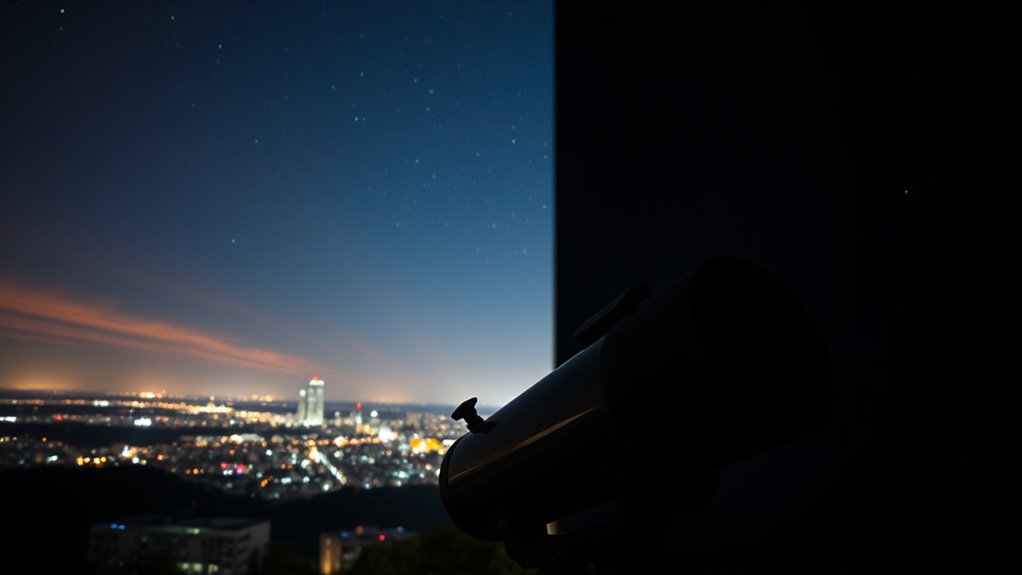
Narrowband filters target specific wavelengths of light, making it easier to suppress unwanted light pollution. This targeted light suppression improves your observation clarity by reducing interference from artificial lights. As a result, narrowband filters provide a clearer view of celestial objects compared to broadband filters. Additionally, glycolic acid, known for its exfoliation benefits, exemplifies how targeted treatments can enhance skin texture and clarity.
Targeted Light Suppression
While both narrowband and broadband filters can help reduce light pollution, narrowband filters excel at targeted light suppression. Their spectral precision allows you to isolate specific wavelengths, effectively blocking out unwanted light sources. This targeted suppression means you can focus on faint objects without interference from streetlights or city glow.
Consider these points:
- Narrowband filters are designed to block specific light emissions, like sodium or mercury vapor lamps.
- They provide precise control over the wavelengths, minimizing light pollution more effectively.
- Their spectral precision ensures minimal loss of important astronomical signals.
- This focused approach results in a much clearer view of deep-sky objects, even in light-polluted areas.
Enhanced Observation Clarity
Targeted light suppression allows you to block specific unwanted wavelengths, but it’s the enhanced clarity during observation that truly benefits from this precision. Narrowband filters, with higher spectral resolution, cut through light pollution more effectively than broadband filters. This reduction minimizes skyglow and isolates faint celestial details, boosting your observational precision. The result is sharper images, clearer star fields, and more accurate data collection. Narrowband filters excel at revealing deep-sky objects that are obscured by urban light pollution. Here’s a comparison:
| Feature | Narrowband Filters | Broadband Filters | Effect on Observation |
|---|---|---|---|
| Spectral Resolution | High | Lower | Better detail and contrast |
| Light Pollution Reduction | Significant | Moderate | Less skyglow interference |
| Clarity of Deep-Sky Objects | Enhanced | Less | Clearer, more detailed images |
| Observational Precision | Increased | Moderate | More accurate observations |
| Ideal for | Light-polluted skies | Less affected areas | Improved clarity in challenging conditions |
Additionally, understanding spectral resolution can help you select the most suitable filter for your observing environment.
Broadband Filters Cannot Capture Faint or Distant Objects Effectively

Broadband filters, by allowing a wide range of wavelengths to pass through, often struggle to detect faint or distant objects effectively. Their broad spectral window can dilute the infrared sensitivity needed for capturing dim signals. This results in a lower signal to noise ratio, making faint objects harder to distinguish from background light. Additionally, the contrast ratio of broadband filters can impact the clarity of faint details in images. To improve detection, consider these factors: 1. Narrowband filters focus on specific wavelengths, enhancing faint signal collection. 2. They increase infrared sensitivity, vital for distant object observation. 3. Narrow filters reduce background noise, improving the signal to noise ratio. 4. Broad filters may miss subtle details, limiting their effectiveness for faint or distant targets. Using broadband filters for faint objects often leads to less clear images, underscoring their limitations in deep-sky observation.
The Cost of Narrowband Filters Is Justified by Their Superior Performance

Although narrowband filters may come with a higher price tag, their ability to substantially improve image quality makes the investment worthwhile. The cost justification lies in their performance benefits, such as sharper images and enhanced contrast. By isolating specific wavelengths, these filters reduce light pollution and atmospheric interference, allowing you to capture faint or distant objects more clearly. While broadband filters let in more light, they often introduce noise that diminishes detail. Narrowband filters’ precision leads to higher-quality astrophotography, justifying their expense for serious enthusiasts and professionals alike. Additionally, their ability to block unwanted light ensures more accurate scientific observations. Ultimately, the improved results and ability to observe faint details make narrowband filters a worthwhile investment, especially when you’re aiming for superior image clarity and scientific accuracy.
All Filters With Similar Wavelengths Perform Equally Well

Do all filters designed for similar wavelengths really perform equally well? Not necessarily. Spectral precision and wavelength matching are vital factors influencing filter performance. Even if filters target the same wavelength, differences in design and manufacturing can impact their effectiveness. Consider these points:
- Spectral Precision: Higher spectral precision ensures the filter isolates a narrow band, reducing unwanted light.
- Wavelength Matching: Precise wavelength matching guarantees the filter aligns exactly with your target emission, improving image quality.
- Transmission Efficiency: Variations in transmission can affect how much light passes through, impacting your observations.
- Filter Coating Quality: Superior coatings maintain spectral precision over time, ensuring consistent performance.
In essence, two filters with similar wavelengths may not perform equally due to differences in spectral precision and wavelength matching, affecting your results.
Narrowband and Broadband Filters Are Interchangeable for All Astronomy Purposes

While narrowband and broadband filters serve different technical purposes, many amateur astronomers believe they can be used interchangeably for all observational tasks. However, the filter material and spectral range are vital factors that differentiate them. Narrowband filters isolate specific wavelengths, often centered on emission lines, with a narrow spectral range, making them ideal for observing faint nebulae and reducing light pollution. Broadband filters, with a wider spectral range, allow more light through, enhancing planetary and galaxy views but sacrificing some contrast. Using these filters interchangeably can result in subpar images or missed details. They’re designed for distinct purposes, and understanding their spectral range and filter material helps you choose the right tool for each celestial target. Additionally, bedroom decor concepts like natural materials and lighting can influence how you set up your observing space for comfort and efficiency.
Frequently Asked Questions
Can Broadband Filters Be Used Effectively for Astrophotography at Night?
Yes, broadband filters can be used effectively for astrophotography at night, especially if they are compatible with your camera and telescope. They help reduce light pollution and enhance contrast, allowing you to capture clearer images. However, for specific emission lines, narrowband filters are better. To achieve ideal image enhancement, ensure your filters are compatible with your equipment and suited for the objects you’re photographing.
Do Narrowband Filters Work With All Types of Telescopes Equally Well?
Narrowband filters are like finely tuned lenses in a symphony of telescopes, but they don’t work equally well with all. Your telescope’s compatibility and the filter’s versatility matter. Some telescopes, especially those with larger apertures or specific optical designs, may struggle with certain narrowband filters. To get the best results, check your telescope’s specifications and opt for versatile filters that adapt seamlessly to your gear.
Are There Scenarios Where Using a Broadband Filter Is Preferable Over a Narrowband Filter?
You might prefer a broadband filter when you need wideband versatility and signal enhancement across multiple wavelengths, especially for capturing more light quickly. In scenarios like wide-field imaging or observing objects with broad emission spectra, broadband filters outperform narrowband ones. They let you collect more signal in less time, making them ideal for general astrophotography or situations where detail isn’t as critical and speed matters more.
How Do Environmental Conditions Affect the Performance of Each Filter Type?
Imagine your filters as shields against environmental interference and atmospheric conditions. Broadband filters, like wide nets, can struggle when gusts of interference blow through, reducing clarity. Narrowband filters, acting as precise spears, excel in harsh conditions, cutting through atmospheric noise. So, when the environment is turbulent, narrowband filters maintain performance, whereas broadband filters may falter, making them less reliable outdoors or in areas with high electromagnetic interference.
Are There Differences in Filter Maintenance and Longevity Between Narrowband and Broadband Filters?
You’ll find that narrowband filters generally require less maintenance frequency due to their precise, specialized design, which minimizes contamination buildup. Their filter durability tends to be higher, often lasting longer in harsh conditions. Broadband filters, however, may need more frequent cleaning because they cover a wider spectrum, making them more susceptible to environmental effects. Proper care and regular checks can extend the lifespan of both filter types, ensuring ideal performance.
Conclusion
Don’t assume narrowband filters always outperform broadband ones. For example, if you’re just starting out and want quick, vibrant images of the Milky Way, a broadband filter might be perfect. Imagine capturing stunning night sky shots from your backyard without breaking the bank. Understanding these differences helps you choose what’s best for your goals—whether capturing faint nebulae or enjoying easier, brighter skies. Make an informed choice, and your stargazing will be more rewarding.




